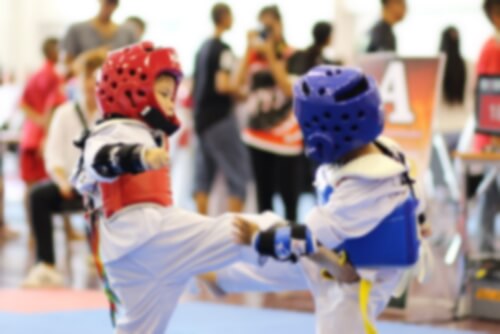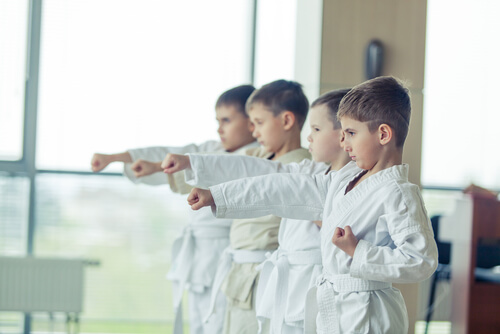Benefits of Taekwondo for Children

In today’s article we’d like to discuss the many social, physical and psychological benefits of taekwondo for children. This discipline requires perseverance, teaches core values and provides great advantages in return.
Contrary to popular belief, this sport is not violent nor does it encourage aggression. It doesn’t even require great strength to practice.
Like other sports, this Korean martial art develops the body’s physical capabilities.
Taekwondo is also a very technical discipline, which helps children learn how to control their body. It provides complete training, giving social and psychological value.
What is taekwondo?
This martial art bases its philosophy on courtesy, integrity, perseverance, self-control and indomitable spirit.
Taekwondo is a thousand-year-old combat sport or martial art of Korean origin. It stands out for a variety of techniques that use the hands, feet, elbows, fists and even knees. It also involves personal defense.
In addition to the physical or technical level, taekwondo represents an entire philosophy based on five principles: courtesy, integrity, perseverance, self-control and indomitable spirit.
It’s one of the best-known and most widespread martial arts. It’s estimated that more than 30 million people practice taekwondo in more than 144 countries.
Taekwondo has also become an Olympic sport. It began as an exhibition sport in Seoul 1998. The first Olympic combat competitions were held during the 2000 Sydney Games.
Equipment needed to practice taekwondo
To practice this sport, a Dobok is necessary. This is the practice suit that consists of pants and a jacket – the equivalent of the kimono in other martial arts. It’s also essential to wear a Ti, the belt that indicates the practitioner’s degree or level.

In combat, the use of polypropylene gloves (pads) and protective boots is usually required. It’s also usually mandatory to use protectors, especially mouth and tongue guards.
In addition, and depending on the level of the participants, you can wear a helmet, protective breastplate, shin guards and forearm protectors.
The benefits of taekwondo
Taekwondo brings great physical benefits, but also various values and skills that help temper the character of children.
This sport can become a way of life for those who practice it. It’s an instrument for achieving physical and mental balance.
Taekwondo seeks the realization of the human being in all senses. In the case of children, it helps them to get through the most complicated stages, acquiring important personal values and healthy habits for life.
Physical benefits
- Improves muscle strength, as well as cardiovascular endurance.
- Increases elasticity, agility and flexibility.
- Helps develop coordination and balance capabilities.
- Provides control and knowledge of one’s body. Since this is achieved through basic movements but on a highly technical level, it will prepare them for future activities of greater difficulty.
Psychological and social benefits
Taekwondo also helps to temper children’s character. Those with high energy levels become more aware of their body and surroundings.
Even the most timid and introverted children will gain confidence, self-esteem and initiative.
- It promotes concentration and discipline.
- By mastering their body, they gain self-esteem and self-confidence. In addition, they will learn to interact with their environment more effectively.
- Important values such as honesty, loyalty, camaraderie, teamwork, respect and humility are fostered.
- It’s an opportunity to foster cultural learning. Through taekwondo, children have access to knowledge of customs, traditions and ways of thinking that are different from their own. It also teaches tolerance and solidarity.

Some taekwondo tips
Although this discipline originated for combat, it isn’t an aggressive sport. The basic training of taekwondo is self-defense, not antagonism.
Moreover, this sport seeks to bring peace and tolerance to those who practice it, among other benefits. It’s an ideal aid to channel the inexhaustible energy of children, especially if they have disorders such as ADHD.
The ideal age to begin practicing this sport is around 4 years old. It’s better to start from a young age, because although taekwondo has great benefits, it’s very technical and “slow.”
Changes don’t happen overnight, and it takes a lot of effort, perseverance and discipline to master the basics and improve.
Therefore, the presence and help of parents is fundamental. They’ll have to remind their children of their values, responsibilities and tasks, encourage them when they believe they aren’t making progress and, above all, support them.
The most important thing is that the child is happy with what he’s doing and the environment he’s in, and that he always puts all his enthusiasm and effort into each and every day of practice.
In today’s article we’d like to discuss the many social, physical and psychological benefits of taekwondo for children. This discipline requires perseverance, teaches core values and provides great advantages in return.
Contrary to popular belief, this sport is not violent nor does it encourage aggression. It doesn’t even require great strength to practice.
Like other sports, this Korean martial art develops the body’s physical capabilities.
Taekwondo is also a very technical discipline, which helps children learn how to control their body. It provides complete training, giving social and psychological value.
What is taekwondo?
This martial art bases its philosophy on courtesy, integrity, perseverance, self-control and indomitable spirit.
Taekwondo is a thousand-year-old combat sport or martial art of Korean origin. It stands out for a variety of techniques that use the hands, feet, elbows, fists and even knees. It also involves personal defense.
In addition to the physical or technical level, taekwondo represents an entire philosophy based on five principles: courtesy, integrity, perseverance, self-control and indomitable spirit.
It’s one of the best-known and most widespread martial arts. It’s estimated that more than 30 million people practice taekwondo in more than 144 countries.
Taekwondo has also become an Olympic sport. It began as an exhibition sport in Seoul 1998. The first Olympic combat competitions were held during the 2000 Sydney Games.
Equipment needed to practice taekwondo
To practice this sport, a Dobok is necessary. This is the practice suit that consists of pants and a jacket – the equivalent of the kimono in other martial arts. It’s also essential to wear a Ti, the belt that indicates the practitioner’s degree or level.

In combat, the use of polypropylene gloves (pads) and protective boots is usually required. It’s also usually mandatory to use protectors, especially mouth and tongue guards.
In addition, and depending on the level of the participants, you can wear a helmet, protective breastplate, shin guards and forearm protectors.
The benefits of taekwondo
Taekwondo brings great physical benefits, but also various values and skills that help temper the character of children.
This sport can become a way of life for those who practice it. It’s an instrument for achieving physical and mental balance.
Taekwondo seeks the realization of the human being in all senses. In the case of children, it helps them to get through the most complicated stages, acquiring important personal values and healthy habits for life.
Physical benefits
- Improves muscle strength, as well as cardiovascular endurance.
- Increases elasticity, agility and flexibility.
- Helps develop coordination and balance capabilities.
- Provides control and knowledge of one’s body. Since this is achieved through basic movements but on a highly technical level, it will prepare them for future activities of greater difficulty.
Psychological and social benefits
Taekwondo also helps to temper children’s character. Those with high energy levels become more aware of their body and surroundings.
Even the most timid and introverted children will gain confidence, self-esteem and initiative.
- It promotes concentration and discipline.
- By mastering their body, they gain self-esteem and self-confidence. In addition, they will learn to interact with their environment more effectively.
- Important values such as honesty, loyalty, camaraderie, teamwork, respect and humility are fostered.
- It’s an opportunity to foster cultural learning. Through taekwondo, children have access to knowledge of customs, traditions and ways of thinking that are different from their own. It also teaches tolerance and solidarity.

Some taekwondo tips
Although this discipline originated for combat, it isn’t an aggressive sport. The basic training of taekwondo is self-defense, not antagonism.
Moreover, this sport seeks to bring peace and tolerance to those who practice it, among other benefits. It’s an ideal aid to channel the inexhaustible energy of children, especially if they have disorders such as ADHD.
The ideal age to begin practicing this sport is around 4 years old. It’s better to start from a young age, because although taekwondo has great benefits, it’s very technical and “slow.”
Changes don’t happen overnight, and it takes a lot of effort, perseverance and discipline to master the basics and improve.
Therefore, the presence and help of parents is fundamental. They’ll have to remind their children of their values, responsibilities and tasks, encourage them when they believe they aren’t making progress and, above all, support them.
The most important thing is that the child is happy with what he’s doing and the environment he’s in, and that he always puts all his enthusiasm and effort into each and every day of practice.
All cited sources were thoroughly reviewed by our team to ensure their quality, reliability, currency, and validity. The bibliography of this article was considered reliable and of academic or scientific accuracy.
- Moody, G. H. (1999). Martial arts benefits for children (Doctoral dissertation, Arizona State University). http://academy.karatebuilt.com/Student_Site/About_Sr_Master_Moody_files/99Thesis.pdf
- Seabrook, J. A. (2003). Martial Arts Revealed: Benefits, Problems, and Solutions. iUniverse.
- Binder, B. (2007). Psychosocial benefits of the martial arts: Myth or reality. Int Ryuku Karate Res Soc J. https://www.researchgate.net/profile/Brad_Binder/publication/265567929_Psychosocial_Benefits_of_the_Martial_Arts_Myth_or_Reality_A_Literature_Review/links/54de00da0cf22a26721db438/Psychosocial-Benefits-of-the-Martial-Arts-Myth-or-Reality-A-Literature-Review.pdf
- Woodward, T. W. (2009). A review of the effects of martial arts practice on health. Wisconsin Medical Journal (WMJ), 108(1), 40. http://wismed.org/wisconsin
- McKeehan, J. (2012). The art of martial behavior: Using martial arts as a behavioral intervention for children with autistic spectrum disorders (Doctoral dissertation, Kaplan University). https://search.proquest.com/openview/24f9b7a28cef81adc54f7853c0801db3/1?pq-origsite=gscholar&cbl=18750&diss=y
This text is provided for informational purposes only and does not replace consultation with a professional. If in doubt, consult your specialist.








